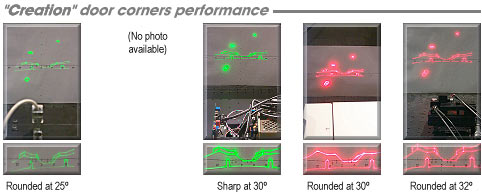![]()

This
page
|
T
|
he photos below show how different
scanners perform when displaying scenes from Lightspeed Design Group's
award-winning show "Creation". The scenes were selected from among those that
look good on 30K-tuned scanners, but look worse on 50K-tuned scanners. To see enlarged views of
any photo button, just click on the button. |
| T | hese photos show rounding where
relatively large steps are occurring. The sample scene is an arena with
doors. On GS G-120 with TurboTrack 2, and CTI 6800 scanners tuned to ILDA 30K, the lower
left corners of the doors meet correctly, at a sharp
corner. However, on the Catweazle at ILDA 30K and the two faster-tuned scanners, the lower left corners are rounded. You can see this better by clicking on the small buttons which show close-ups of the doors. This frame is one of many in the Creation show where rounding occurs at 50K but not at 30K. To solve this, the show would have to be played at a smaller scan angle, or would have to be output at a slower point rate (fewer points per second).
|
|
About power limitingClick here for additional information on power limiting.Notice that the TrueK 50 power limiting, in
both the abstract and raster photos, is symmetrical. In contrast, the
Cambridge 6210's power limiting is asymmetrical.
|
W | ith the rounding problem,
audience members may not notice -- especially if they have not seen the
normal, non-rounded version of a show. But audience members will
definitely notice the next problem. This is "power limiting". It happens when showing an image with so many large jumps that the scanner may overheat. The scanner amp limits the signal to prevent overheating. Power limiting is already present on the Cambridge 6800 tuned to ILDA 30K. But it happens significantly more often with the two faster-tuned scanners. Both of them shrink this particular abstract, when it shows fine on ILDA 30K-tuned 6800s. In fact, they go beyond shrinking, because the resulting image (in this case) looks like a scribble. Such distortion is unacceptable. The only solution is to reduce the size of either the abstract within the show or the entire show.
|
About the raster imagesThe tests were done with colors turned off (all-green or all-red images). This is why the rasters shown here don't have pictures, just light and dark areas.Raster images are normally square. The ones shown here are from a scene where a square raster "blows up" like a balloon. This is why the rasters have curved lines instead of straight. |
A | nother unacceptable distortion
can occur with raster images. These images require the scanner to slowly
scan a line from left to right, then to snap back to the left as fast as
possible. The raster below is large enough that power limiting occurs on the two faster-tuned scanners. Again, the solution is to reduce the size of either the raster within the show or the entire show.
|


